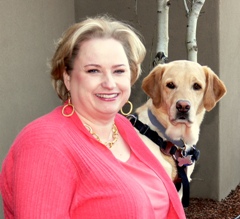Blogging for the Dog
Author: Ellen Cline; Published: Aug 27, 2010; Category: Editing and Proofing; Tags: blogging, Persuading Readers, Point-of-View, promoting nonprofits, Public relations; No Comments

This summer I haven’t written for my own blog at all. I’ve been busy with a variety of projects, but the one that was the most involving, and fun, was National Assistance Dog Week.
Yes, I really was blogging for the dog: Whistle, my client Marcie Davis’ assistance dog, to be exact. Just like his partner, Marcie, that dog is an overachiever. Being the co-host of the Working Like Dogs show on Pet Life Radio just wasn’t enough. He also had to start blogging. But he needed a little help from me and Marcie to pull that off.
I wasn’t just blogging for the dog; I was helping Marcie promote National Assistance Dog Week to individuals and organizations around the country. We put together a website, www.assistancedogweek.org, with Evolution Web, promoted NADW and the website, posted events being held in various states and organized our own events here in New Mexico.
We partnered with Assistance Dogs of the West and got Governor Bill Richardson to sign a proclamation, had an Assistance Dog Fair at Zoe & Guido’s Pet Boutique, and received press coverage for these events.
Then we got Betty White and Ali MacGraw to be guests on the Working Like Dogs show in honor of National Assistance Dog Week. Having celebrity guests brought lots of attention to Marcie’s show, and to NADW. Since then, I’ve also helped Marcie contact and book animal issues reporter Jill Rappaport from the Today Show, and entertainer and guide dog partner, Tom Sullivan.
I’ve been involved with helping my amazing client, Marcie Davis, with a number of her projects. She does so many different things, it makes my head spin. Besides Working Like Dogs and National Assistance Dog Week, she has a nonprofit called Soulful Presence and a company called Davis Innovations. All the work these organizations do is to help people and animals, both locally and globally.
Marcie is ceaseless in her efforts for others. But despite all the work she did, and does, nobody really knew about it. I’m trying to help her get more attention for her causes and projects, in hopes of building awareness and enabling her to be able to do even more good.
Style manuals and style guides—tools for building consistency
Author: Ellen Cline; Published: Apr 5, 2010; Category: Business Writing, Communications Tools, Editing and Proofing, Message Simplicity; Tags: Business Writing, consistency, style guides, style manuals, writing, writing reference books; No Comments
Choosing and using a style manual and producing and using an in-house style guide help a company create and maintain consistency in their communications. Consistency always furthers an organization’s professional image.
The style manual most people seem to have heard of is the Associated Press Stylebook. I’ve done work for organizations where I’ve been told things like: We follow AP style but we use the title Dr. for our researchers preceding their names which AP says not to do. Then the client might go on to tell me several other ways their house style diverges from AP style.
Exceptions like this should be covered in a company style guide. The in-house style guide might spell out items like the usage of the company product names and logos, but it also can detail where company usage differs from the guidelines set forth in the style manual.
I did not study Journalism in college so I did not learn about AP style until later in my career. When I had to follow it for some projects my first thought was, you’ve got to be kidding. To me, the book has always been difficult to use and illogical as it has:
- No index.
- A system for filing items under alphabetical titles that seemed haphazard, at best.
- Rules that supposedly stemmed from the limitations of metal type.
Even though it is considered a guide for academic writing, I prefer the Chicago Manual of Style as a reference. It has an index so you can find things. And there are a lot more things to find as the book is really comprehensive, including information about grammar. Not everything in it applies to every project. But it’s somewhere to start.
First, if your group does not have a particular style manual it follows, you might want to decide which would be best suited for your needs. Elizabeth G. Frick and Elizabeth A. Frick wrote an article in the Society for Technical Communication magazine, Intercom, which discussed style manuals and style guides and referred readers to a handy style manual matrix they created that compares the different style manuals. Their chart shows the history and purpose of each book, and can help you choose which you might want to use.
Style manuals do differ on what they feel is correct on topics like hyphenation, formatting of web addresses, and the serial comma, aka the Oxford comma. Believe it or not, people get excited about whether or not it is proper to use that last comma in a series before the “and.” I recently found out there’s even a Facebook group, "Students for the Preservation of the Oxford Comma." (For the record, I like the serial comma as it does add clarity in many situations. AP, however, says no to the serial comma.)
Style manuals give you rules and standards for writing and formatting different types of written materials. They do not all agree on what the standards are. Your company or organization may have decided which style manual to follow, but then there are inevitably exceptions to the rules. In that case a style guide might be created, just for your organization.
Your style guide doesn’t need to repeat what is in your chosen style manual; it can just talk about where your in-house style differs from the reference book and tackle issues of interest to your organization.
Word woes–homonym horrors, the sequel
Author: Ellen Cline; Published: Mar 8, 2010; Category: Editing and Proofing; Tags: editing, homonym errors, proofreading, spellchecker; No Comments

Even the greatest spellchecker is not going to save you from using a word that might seem correct, but just isn’t quite “write.”
The odds of falling into this trap have increased as word processing programs try to “help” you by inserting the word they think you want and need. It’s easy to get lulled into a false feeling of security as the computer assures you that everything has been checked for spelling. So how can you end up with the wrong word?
Just remember, the machine may help you find some errors, but it’s more than happy to add more. If you use a word that’s spelled correctly, that doesn’t mean it’s the word you want. It could be a homonym, just waiting to inflict horror, right when you least expect it.
Yes, it’s time for another episode of homonym horrors.
- From a cartoon strip, where a character is reminiscing about her experiences in WWII—I kept seeing Lieutenant Kiesl because the camp was sort of an entrance point, a weigh station for arriving P.O.W.s who were interrogated then sent on to other camps. Meanwhile…”
(I think they mean way station. I doubt if the purpose of the place was to see how much the P.O.W.s weighed) - From a high tech magazine article—Subhead: A device can power indefinitely to wireless censors
(I doubt they meant censor here, unless this is supposed to be top secret technology. But then they wouldn’t be writing about it in this magazine, would they? Besides the homonym problem, the subhead is badly written. Maybe it should say: Device can provide power indefinitely to wireless sensors.) - From a healthcare organization member newsletter—Subhead: A complementary benefit.
(This is a common mistake. Since this section of the article is about a service that members don’t have to pay any additional fees for, a.k.a. free, they should have used complimentary. There is something called complementary medicine, however, it’s generally not free. - From a dentist’s direct mail piece–We work to educate all our patients so that they can take an active roll in their treatment…
(Bread rolls are inanimate objects, and I doubt they’re talking about a roll in the hay, so we’ll assume they mean an active role.) - From an email—I am in the throws of an RFP deadline and up to my eyeballs in other deadlines.
(We’re not struggling to throw a ball here. The desired word was throes.)
We all misuse homonyms at one time or another. Sometimes it’s due to careless typing. Other times it’s caused by misunderstandings about the difference in meaning between words that sound the same but are spelled differently.












